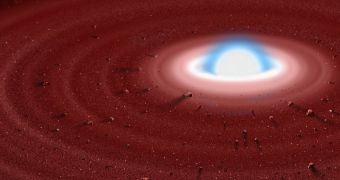There were no little green creatures what astronomers discovered, but a burned out white dwarf star with what was left from an Earthlike planet orbiting it.
The chemical fingerprinting revealed that these are the remains of a system very similar to the Sun's, and gives hope that these could be common across the Universe. Now, we just have to detect them before supernova explosions turn them into space junk.
The white dwarf star, called GD 362, is situated at roughly 150 light-years from Earth and displays a ring-like structure similar to Saturn's.
The UCLA astronomers have detected the rocky asteroid interacting with the white dwarf. In a recent past, an asteroid was destroyed by the high gravitational powers around the compact object, and the dust has contaminated the white dwarf's atmosphere.
The relative abundance of the asteroid's elements fits the chemical patterns of the planets in the inner Solar System, like high iron and calcium amounts, and low levels of carbon. The composition of the asteroid ripped apart by gravitational forces of the GD 362 is similar to the Earth's crust.
"What we have here is a composition of the white dwarf that is fairly similar to that of the inner planets of our solar system. Are there other terrestrial planets like Earth in other solar systems? This white dwarf's fingerprint is a significant advance in demonstrating that something like terrestrial planet formation occurred around this other star and probably occurred around other stars as well, because it suggests the Earth's composition is not unique.", said co-author Michael Jura, a UCLA professor.
It appears that the same forces that shaped Earth and the planets in our Solar System occurred around GD 362, during our planet's cradle stage. This also comes with clues about our own future, and of the Earth and Sun. In about 5 billion years, when our Sun will experience hydrogen fuel shortage, it will expand enormously, swallowing the inner planets, and could reach even the Earth.
The orbits of the outer planets could shift, and inward spiraling could toss them into the Sun. Outward spiraling could throw some into interstellar space, and others could collide into increasingly smaller objects. This way, our own Sun could be surrounded by a ring of leftover planetary material, and some chunks would be Earth pieces.

 14 DAY TRIAL //
14 DAY TRIAL //